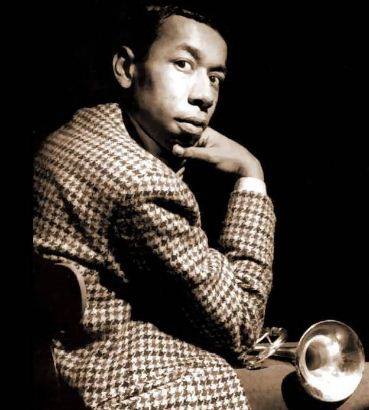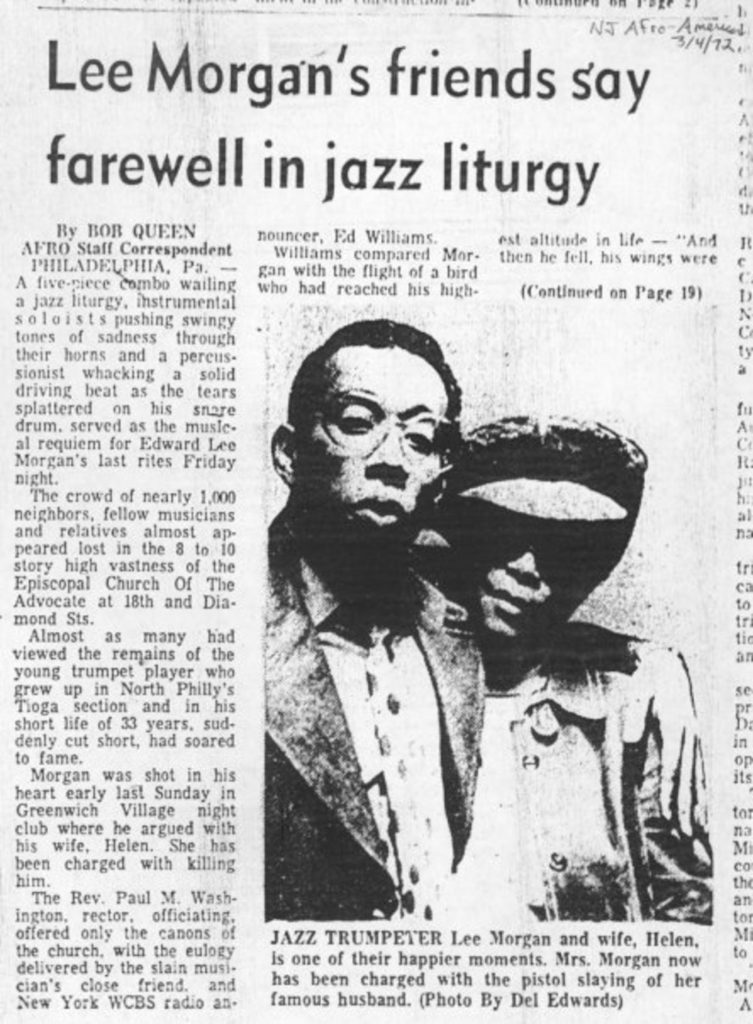Lee Morgan, East Village Jazz Trumpet Prodigy
Lee Morgan, prodigy jazz trumpeter, born on July 10, 1938, in Philadelphia. One of his sisters bought him his first trumpet, and by the time he was a teenager he played with John Coltrane for the album Blue Train. At 18, Dizzie Gillespie tapped Morgan to join his band. The jazz world opened up before him. Starting in the 1960’s, Morgan was a regular performer at Slugs’ Saloon at 242 East 3rd Street, between Avenue B and C, where – well, let’s say, headlines were made.

Success and Tumult
Once Dizzie Gilespie disbanded his group for financial reasons, Lee Morgan was well established in the jazz world. He began recording for Blue Note Records in 1956, eventually recording twenty-five albums as a leader for the label. Morgan recorded thirty-one albums total in lead role and played as a side player on over a hundred albums with various bands and musicians. In his late teens and early twenties, Morgan also began touring and composing. It was two of his tour-mates in Art Blakey’s Jazz Messengers who introduced Morgan to heroin.
Morgan’s story mirrors many young stars and jazz musicians of the time – heady with fame and innovation and virtuosity. And danger. The country and industry both idolized and derided the jazz community. Record deals, tours, segregation and racist Jim Crow laws were all part of the mix. In 1963, Morgan’s most successful record The Sidewinder was released. Chrysler used a song from The Sidewinder for a commercial, and when Morgan’s lawyers got involved, Chrysler took the commercial off the air but never paid for the use of the song or penalties. This and other factors led to Morgan becoming politically involved as a leader of the Jazz and People’s Movement. The Movement’s mission was to protest racism and its skewed publicity opportunities in the music industry, especially in television. Morgan kept working, despite these systemic challenges.

Addiction and Recovery
Morgan was addicted to heroin for ten years. In the cold Manhattan winter of 1967, with his coat and trumpet in hock to support his addiction, he met a woman named Helen. Helen was a devotee of the jazz world, and known for being “square” herself, but for helping struggling musicians. She bought Morgan his coat and trumpet back, and from then on, she said, “he hung on to me.” They fell in love, and Helen “took over total control” of Morgan, helping him get well and working again. Within a year of meeting, the couple settled down in the Bronx. Helen took Lee’s last name, and they began introducing themselves as husband and wife, even though they never legally married.

Morgan began teaching music in New York schools. He got more involved with the Jazz and People’s Movement. He started seeing other women – for pleasure, but also for the pragmatic reason that it was hard to get from the downtown Jazz clubs back to the Bronx after a late, wild show. Around this time, Helen started carrying a gun.
Slugs’ in the Far East

The business at 242 East 3rd Street (now Rossy’s Bakery) was first a Ukrainian restaurant and bar. In 1964, owner Jerry Schultz opened it as a club and initially called it “Slugs’ Saloon.” He later changed the name to “Slugs’ in the Far East.” Long and railroad style, the bar had a capacity for 75 people but often held twice that. Prominent jazz musicians performed including Sonny Rollins, Albert Ayler, Ornette Coleman, and many others. Some of these performances were recorded – with or without the musicians’ knowledge – and appear unofficially released or on bootleg albums. Well-known artists flocked to Slugs’ for their shows, from Larry Rivers to Salvador Dalí.
The Gun at Slugs’
On February 19, 1972, it was blizzarding in New York and Morgan was on his way to Slugs’ for a show. His car spun out in the snow, so Morgan abandoned his car, took his trumpet, and walked the rest of the way. People crowded the bar with their coats and cigarette smoke. Morgan was scheduled at Slug’s for the whole week and was staying in the Village, so Helen hadn’t seen him in a while. She decided, in the blizzard, to go down to the East Village to watch him perform. Walking into Slugs’ she saw Morgan, between sets, at a table with another woman. They approached each other with hostility, and Morgan threw her out of the bar.

“I didn’t have on my coat or nothing, but I had my bag,” Helen recalled. “He threw me out the club. Wintertime. And the gun fell out my bag, and I looked at it. I got up. I went to the door….The bouncer said to me, ‘Miss Morgan, I hate to tell you this but Lee don’t want me to let you in.’ And I said, ‘Oh, I’m coming in!’ I guess the bouncer saw the gun…He said, ‘Yes you are.’ And I saw Morgan rushing over there to me and all I saw in his eyes was rage.”
And so, as Chekov would have it, the gun was fired a single time, hitting Lee Morgan near his heart. It took the ambulance too long to get all the way east in the blizzard, and so Lee Morgan’s life ended at the hands of the woman who had saved him five years earlier. Morgan was 33 years old.

The shooting cast a dark shadow over Slugs’. Combined with the challenging neighborhood landscape, and difficulties of club ownership, Schulz decided to close Slugs’ in late 1972.
Lee Morgan’s Legacy and Recognitions

Reading the long-form story of Lee and Helen is well worth it. As is watching the 2017 documentary I Called Him Morgan. The film is based on an interview with Helen Morgan in the 1990s after she had been released on parole. She pled not guilty to charges of second-degree manslaughter, but her case files were lost, so her sentence remains unknown.
The tragic death of Lee Morgan is now part of jazz mythology. In the decades following his death, Blue Note released previously unheard recordings. All to great critical acclaim, which is undiminished. Morgan is remembered as a prodigy, virtuoso, activist, and strong personality.

Fascinating EV story, thank you!
I went to Slugs several times between mid 1971 and August 1972. I first went to see McCoy Tyner’s group, saw them on 3 or 4 occasions (Sonny Fortune, Woody Shaw, Herbie Lewis, Freddie Waits). Subsequently, saw Mingus’s quintet (including Bobby Jones, and Roy Brooks) before the Philarmonic Hall concert, Larry Coryell’s band as well as Herbie Hancock’s Mwandishi group, and Sun Ra’s Arkestra (twice).
The best way to describe an evening at Slug’s was that it felt like you were walking in music from one of those firey Blue Note mid 60’s sessions. I was just starting to listen to jazz then, and I can’t think of a better way to have had an initial exposure to the music, than being at Slugs.
Watched the documentary “I Called Him Morgan”. Enjoyed it very much. I haves been listening to Lee Morgan’s music every since.
Some Friends & I planning on attending the set @ Slug’s
that evening until, the Blizzard hit.
Next day (Sunday),there were 14 inches of Snow on the ground & a local news source reported that Brotha Lee had been shot & killed @ Slugs the evening before by an unidentified woman.
I called My Friends & asked if they had heard the news, all said NO & that when I delivered the bad news.
#TRUE STORY!